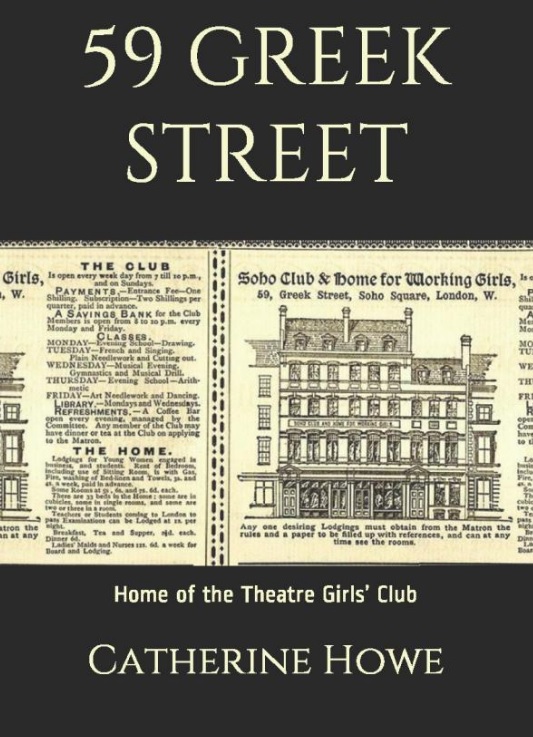59 Greek Street: home of the Theatre Girls' Club

|
| 59 Greek Street: home of the Theatre Girls' Club, Soho, London, Catherine Howe, APS Books, Aberford, West Yorkshire, LS25 3AE, 2021, 164 pages, not illustrated. |
‘A secure place in an insecure world.’ Those words come near the end of this unusual book that explores a neglected topic: the capital’s hostels and places of refuge from its bleak and threatening streets. 59 Greek Street, a large house near Soho Square at the heart of London’s west end, was first set up as a ‘club and home for working girls’, whose history is traced in these pages through personal memories. To some degree adopting the history-in-real-time genre of many TV documentaries, the author skilfully evokes the everyday lives of the building’s inhabitants. For a scholarly account of Greek Street’s beginnings, see the two 1966 volumes of the Survey of London, available at British History Online.
59 Greek Street is within the walls of a five-storey, Italianate building of about 1880. The basement was formerly used by the theatre girls as a rehearsal space, but all the floors above have been gutted for modernisation. The Victorian staircase has also been lost. Fortunately, the ground-floor street frontage was retained and is in elegant retail use, with detailing that closely resembles the original appearance as depicted on the book’s front cover. During its first few decades, the building, with its dormitories, dining room, chapel, laundry and roof terrace, offered a temporary home to seamstresses, shop assistants and other female employees in the area, who were known as ‘working girls’. From 1917 until the late 1960s it came under the control of Sir Compton Mackenzie (1883–1972) and his family. With their theatre links, they transformed the tall house into a secure, although spartan, home for female performers from the Soho and wider area.
We learn in detail about the lives of these young women (some of whom stayed on into their later years). The building stood at the hub of London’s sex trade during the two world wars and beyond, when soldiers and sailors scoured the streets in search of relief. As the Theatre Girls’ Club, it excluded males and gave preference to performers; in turn, these young women, mostly in their early teens on arrival, were excluded from normal lodging houses. While attending their auditions and rehearsals for dance routines, they found out about No 59 on the show-biz grapevine, thus enabling them to sleep in proper beds and much more securely than in London’s parks.
The book provides a vivid account of life at the club, derived from first-hand accounts in letters sent to Catherine Howe, who herself once lived there. The narrative of a historic building seen from the inside, combined with aspects of west-end entertainment, make for a unique perspective. The world of song and dance extended out from 59 Greek Street to provincial theatres and even to the ships that cruised the oceans. There is a full index and bibliography, and notes to help with further research – perhaps on some of the hostels, soup kitchens, religious and medical centres for minorities and the vulnerable, whose historic buildings can still be found in our streets, but whose lives are often forgotten.
This article originally appeared as ‘Working girls’ in the Institute of Historic Building Conservation’s (IHBC’s) Context 172, published in June 2022. It was written by Graham Tite, a Soho Society member.
--Institute of Historic Building Conservation
Related articles on Designing Buildings
IHBC NewsBlog
Old Sarum fire in listed (& disputed) WW1 Hangar - Wiltshire Council has sought legal advice after fire engulfed a listed First World War hangar that was embroiled in a lengthy planning dispute.
UK Antarctic Heritage Trust launches ‘Virtual Visit’ website area
The Trust calls on people to 'Immerse yourself in our heritage – Making Antarctica Accessible'
Southend Council pledge to force Kursaal owners to maintain building
The Council has pledged to use ‘every tool in the toolbox’ if urgent repairs are not carried out.
HE’s Research Magazine publishes a major study of the heritage of England’s suburbs
The article traces the long evolution of an internal programme to research 200 years of suburban growth
IHBC Context 183 Wellbeing and Heritage published
The issue explores issues at the intersection of heritage and wellbeing.
SAVE celebrates 50 years of campaigning 1975-2025
SAVE Britain’s Heritage has announced events across the country to celebrate bringing new life to remarkable buildings.
IHBC Annual School 2025 - Shrewsbury 12-14 June
Themed Heritage in Context – Value: Plan: Change, join in-person or online.
200th Anniversary Celebration of the Modern Railway Planned
The Stockton & Darlington Railway opened on September 27, 1825.
Competence Framework Launched for Sustainability in the Built Environment
The Construction Industry Council (CIC) and the Edge have jointly published the framework.
Historic England Launches Wellbeing Strategy for Heritage
Whether through visiting, volunteering, learning or creative practice, engaging with heritage can strengthen confidence, resilience, hope and social connections.














